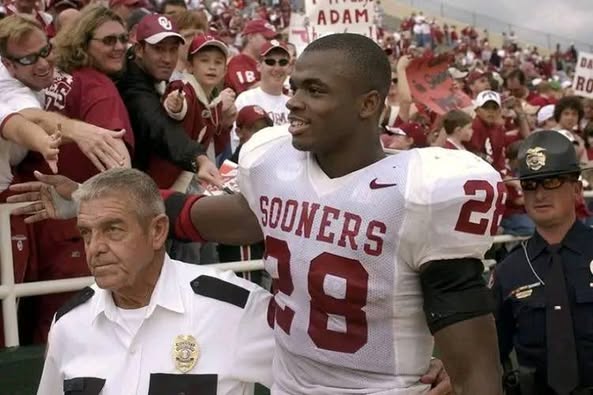In an unprecedented show of commitment to both their alma mater and the next generation of athletes, University of Oklahoma legends Adrian Peterson and Keith Jackson have once again solidified their status as two of college football’s most impactful figures, not just on the field but off it as well. The announcement of their multi-million dollar endowment marks a defining moment in the history of the Oklahoma football program and highlights a growing trend among former players leveraging their success to give back in transformative ways. This initiative, which is designed to simultaneously support the University of Oklahoma and foster youth development, demonstrates Peterson and Jackson’s deep-seated dedication to the game, to their community, and to the broader mission of shaping the next generation of leaders both on and off the field. Their legacy as one of college football’s greatest playmaking duos is now etched not only in the record books but also in the tangible opportunities they are creating for future students and athletes.
Adrian Peterson, widely regarded as one of the most electrifying running backs in NCAA history, brought a combination of speed, power, and vision to the Oklahoma backfield that few in the sport have ever matched. His time at Oklahoma was marked by record-breaking performances, unforgettable plays, and a work ethic that set the standard for teammates and opponents alike. Peterson’s athletic feats at Oklahoma—ranging from his explosive runs to his ability to perform under immense pressure—ensured that he would not only leave a lasting mark on the program but also serve as an inspirational figure for young athletes who aspire to reach the pinnacle of college football. Meanwhile, Keith Jackson, one of the most dominant tight ends of his era, redefined the position with his unmatched combination of size, agility, and football intelligence. Jackson’s ability to make clutch catches in critical moments complemented Peterson’s dynamic rushing game, forming a synergy that became the cornerstone of Oklahoma’s offensive success during their overlapping tenures. Together, their on-field chemistry created one of the most feared duos in college football history, earning accolades, championships, and the admiration of fans nationwide.
The decision by Peterson and Jackson to launch a multi-million dollar endowment is a direct reflection of the values that defined their time at Oklahoma. Beyond the fame and accolades, both athletes have always expressed a deep desire to give back to the community that shaped them. This endowment, which is being directed toward scholarships, youth sports programs, and broader initiatives to improve access to higher education, will have a lasting impact that reaches far beyond the confines of Gaylord Family Oklahoma Memorial Stadium. By targeting youth development, Peterson and Jackson are ensuring that young athletes—especially those from underserved communities—have the resources, mentorship, and support needed to achieve their full potential. In doing so, they are creating a pipeline of opportunities that mirrors the path that led them to greatness, offering guidance, inspiration, and tangible support to the next generation.
Historically, the University of Oklahoma has produced a host of legendary athletes, but the combination of Peterson and Jackson stands out not just for their individual brilliance, but for the way their talents complemented each other. While Peterson’s highlight-reel runs electrified crowds and demoralized defenses, Jackson’s presence as a reliable, game-changing target provided balance and versatility to the Sooners’ offense. This duo not only dominated games statistically but also created a culture of excellence that extended to every member of the team. Their collaboration embodied the essence of teamwork, proving that football, at its best, is about leveraging complementary strengths to achieve a common goal. The new endowment continues this philosophy, translating their on-field synergy into a model for educational and athletic collaboration that can have profound implications for students, athletes, and the community at large.
The financial scale of the endowment is noteworthy, reflecting both Peterson and Jackson’s understanding of the long-term needs of the University of Oklahoma and the youth they aim to support. While exact figures remain confidential, insiders report that the multi-million dollar fund will be managed in a way that ensures sustainable growth, allowing scholarships, training programs, and community initiatives to flourish for decades. This type of strategic philanthropy is increasingly recognized as a vital component of university athletics, as it provides stability and resources that can elevate programs beyond the limitations of annual budgets or fluctuating donations. By committing to such a significant endowment, Peterson and Jackson are not only enhancing their own legacies but are also setting a benchmark for what alumni can achieve when they channel their success into structured, high-impact giving.
One of the most compelling aspects of this initiative is its dual focus on both higher education and youth athletic development. For Oklahoma students, the endowment will expand access to scholarships and academic resources, reducing financial barriers for talented individuals who might otherwise be unable to pursue a college degree. In parallel, the youth programs funded by the endowment will emphasize skill development, mentorship, and life skills, ensuring that young athletes gain more than just technical proficiency. Peterson and Jackson’s approach acknowledges that success in football—and in life—requires a foundation of education, discipline, and guidance. By investing in these areas, they are creating a comprehensive support system that mirrors the values that guided their own athletic and personal journeys.
The ripple effects of this initiative are already being felt within the University of Oklahoma community. Coaches, administrators, and current players have expressed enthusiasm about the opportunities the endowment will create, highlighting how it can serve as a recruiting tool, a morale booster, and a source of pride for the program. Prospective athletes, in particular, may view the support network established by Peterson and Jackson as a compelling reason to commit to Oklahoma, knowing that their development—both on the field and academically—will be prioritized by two of the program’s most respected alumni. Moreover, this endowment underscores the importance of legacy in college sports, demonstrating how former players can continue to influence a program long after their playing days have ended.
Community leaders and youth advocates have also praised the initiative, noting its potential to reshape opportunities for young athletes in the region. In many communities, access to high-quality sports programs is limited, and the mentorship that Peterson and Jackson provide can be as valuable as financial support. By linking the endowment to youth development, they are addressing systemic gaps in athletic training, education, and personal growth, creating a model that other former athletes may be inspired to follow. The impact of such programs can be profound, fostering confidence, resilience, and ambition in young people who may have faced obstacles in accessing resources that were more readily available to Peterson and Jackson during their formative years.
This endowment also serves as a powerful statement about the long-term value of investing in human capital. Peterson and Jackson understand that their greatest legacy extends beyond the records they set, the championships they won, or the highlights that continue to circulate in sports media. Their true impact lies in the lives they touch, the opportunities they create, and the pathways they open for future generations. In a landscape where professional athletes often focus primarily on personal brand-building or short-term financial gains, their decision to dedicate substantial resources to education and youth development distinguishes them as forward-thinking leaders who recognize the broader responsibilities of their position. It is a rare and inspiring example of sports figures leveraging their prominence to enact meaningful societal change.
The narrative surrounding Adrian Peterson and Keith Jackson has always been intertwined with themes of excellence, perseverance, and vision. From their early days at Oklahoma to their professional careers and now to their philanthropic endeavors, both athletes have consistently demonstrated an ability to turn talent into impact. The endowment represents a natural extension of this trajectory, allowing them to channel the same focus, determination, and strategic thinking that defined their playing careers into initiatives that will bear fruit for years to come. For students, athletes, and community members alike, the message is clear: success is most meaningful when it is shared, and true greatness is measured not only by what you achieve personally but by the doors you open for others.
The Oklahoma community is now witnessing a new chapter in the story of Peterson and Jackson—a chapter defined not by touchdowns or receptions but by the enduring influence of their generosity and vision. By investing in education and youth development, they are ensuring that the University of Oklahoma remains a hub of excellence, innovation, and opportunity, while also cultivating the next generation of leaders who will carry forward the values of dedication, teamwork, and resilience that have long been associated with the program. In doing so, they reinforce the idea that college athletics can serve as a powerful platform for societal impact, blending performance with purpose in ways that benefit entire communities.



